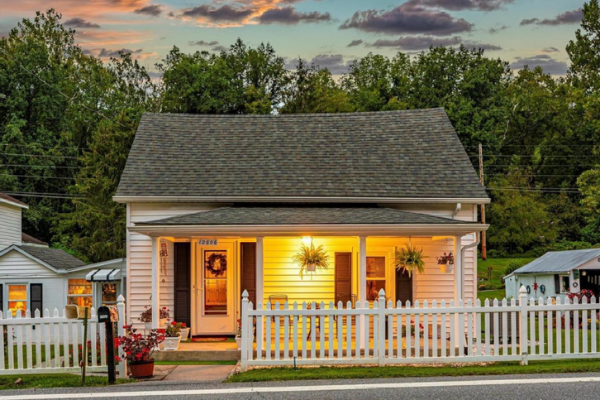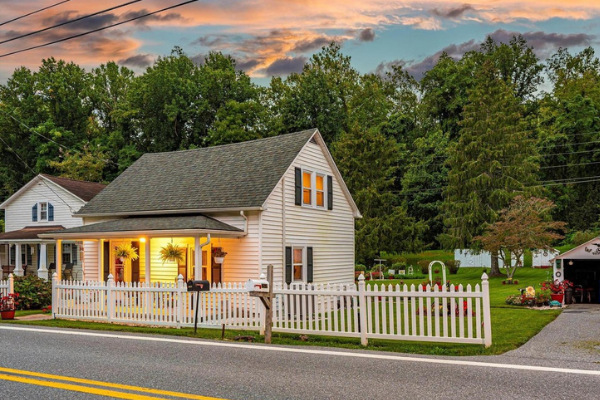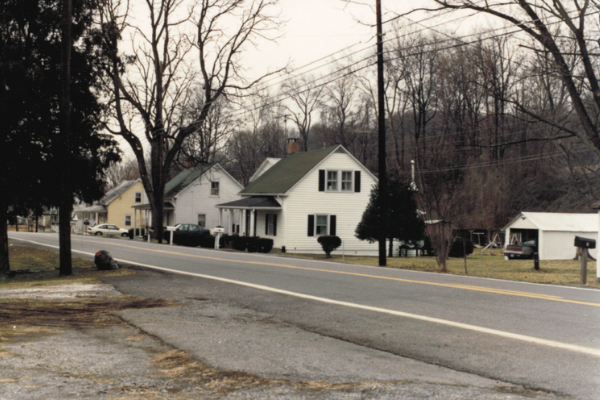Content courtesy of Elizabeth Comer, President of CFHS
The Ausherman Family Foundation awarded the Catoctin Furnace a grant to help purchase 12606 Catoctin Furnace Road, one of the original log worker houses in Catoctin Furnace. Octogenarian Joann Miller, the last of her immediate family, decided to sell the property and move to a condo in autumn 2021. The current owner wanted to sell the house to the Catoctin Furnace Historical Society (CFHS) to preserve its historic nature and to ensure that the house was not raised by a larger developer. The Single-Year Grant enables the Catoctin Furnace to begin an annual resident fellows program teaching emerging professionals heritage tourism and historic preservation building and restoration skills.
Historical Significance
The property was part of the industrial complex which began operation in 1776. Historical records indicate that as many as 80 worker homes were built around Catoctin Furnace in the late 18th and 19th century. Today, only 10 remain, 6 log and 4 stone. The importance of the industrial complex was recognized on February 11, 1972, when the structures and associated archaeological resources were listed on the National Register of Historic Places. The log and stone worker houses, including 12606 Catoctin Furnace Road, were cited as contributing resources to the site significance. Douglass Reed studied the structures at Catoctin Furnace and postulated that they were built ca. 1810 to 1820.
The property was home to many residents over 200 years, however, their names are lost as company records did not record tenants renting specific structures. In a 1982 interview, Mary Miller Martin stated, “there are strong traditions that certain houses at Catoctin Furnace were at one time slave quarters,” although she did not identify specific structures. It is possible 12606 was the home of enslaved Africans before it housed European immigrants. The labor to build the structure in the first quarter of the 19th century was undoubtedly enslaved Africans owned by the Johnson brothers (1776-1811) or Willoughby Mayberry (1811-1820).
The last owners of the furnace, Lancelot Jacques, Sr., and Stanley E. Hauver, sold the houses separately for the first time in 1923. William Keller Carty and his wife Carrie Blanche Sweeney Carty purchased the property for $450.00 on August 25, 1923, and it remained in the Carty/Miller family until the present day. It includes a summer kitchen/washhouse, a privy, a shed, and a garage.
Future Plans for the Worker House
The Ausherman Family Foundation grant facilitated the purchase of the historic dwelling, its archaeological resources, and outbuildings. It will ensure preservation of the dwelling, outbuildings, and streetscape, providing the opportunity for future intangible deliverables including the furnace fellows program. In the future, when funds are available, CFHS intends to restore the structure, including replacement of the modern shingle roof with a hand crimped standing seam tin roof and replacement of the vinyl siding, among others. Future use of the dwelling will be to house Furnace Fellows in an innovative one-year paid residential research and professional development program. Each year two new Fellows will join the site and participate in the research and public interpretation of the industry and workers. Through research, seminars, and hands-on projects, Furnace Fellows will conduct significant primary research, gain professional museum experience, and learn about heritage tourism including:
• Attend an initial intensive one-week seminar with leading scholars and heritage tourism professionals
• Conduct in-depth yearlong research that leads to a major project and /or paper based on their work.
• Lead tours of the historic site, buildings, and landscape, and have full engagement in interpretive programming.
• Work closely with the CFHS board and staff on projects that will include heritage tourism, museum and historic site management, collection care and research, exhibition planning, educational programming, and special events.
• Participate in various events and staff/board meetings to learn about the structural, economic, strategic, and creative decisions involved in the day-to-day operations of an historic site and museum.
• Attend monthly field trips and site visits to museums, heritage tourism sites, and cultural venues; benefit from professional development opportunities including resume review and next step planning based on individual career goals.
The future fellowship program will provide training and mentoring to emerging professionals for the heritage tourism industry. Fellows will be recent college graduates and/or graduates from the National Park Service Traditional Trades Apprenticeship Program or The Campaign for Historic Trades Program. Living and working in the historic village, the fellows will receive hands on training for their career and mentorship within the heritage tourism field.
Elizabeth Comer, president of the Catoctin Furnace, comments that:
The Ausherman Family Foundation grant makes it possible to realize a decade-long plan to create and sustain an annual emerging professional fellowship program at Catoctin Furnace. The generosity and foresight of the Ausherman Family Foundation, supporting the first fellowship of its kind in Frederick County, paves the way to establish similar programs to teach the next generation hands on preservation building trades and heritage tourism skills



The Worker House at the Catoctin Furnace in 1988.
Click here for a pamphlet of information on the Catoctin Furnace
Interested in more news articles?
Check out other happenings and interesting news related to the Ausherman Family Foundation and Frederick County, MD.